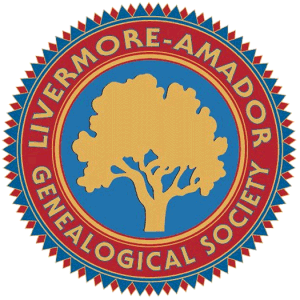 |
The Livermore Roots Tracer
Volume 27 Number 4
November 2007
Editor: Jane Southwick
Reporters: Kay Speaks, Marie Ross, Lois Barber, Lois Smith
Compositor: George Anderson
Web Editor: Vicki Renz
Printing/Distribution: Sandra Caulder
Staff Contributors: G.R.O.W - Frank Geasa
Our e-mail address: rootstracer@l-ags.org |
The Roots Tracer is the quarterly publication of the Livermore-Amador Genealogical
Society. The mission statement of the Roots Tracer is: "Instruct. Inspire.
Inform." We encourage members to submit articles for publication. Material can be
e-mailed to: rootstracer@l-ags.org or mailed to
L-AGS, P.O. Box 901, Livermore, CA 94551-0901.
Queries are free. Please send your queries to querymaster@l-ags.org.
Table of Contents

|
A Message from Our President
Anne Marshall Homan
|
I always think of November as sort of a resting place. For students and teachers, it
interrupts the long stretch of time from Labor Day and the beginning of the school year
with two holidays - Veterans' Day and Thanksgiving Day. Most college students can come
home for Thanksgiving. For the rest of us, the month is the calm before the storm of the
holiday season. It is even a time when I might find a few moments of quiet to work on my
genealogy!
Whenever you go to the Livermore Library, please take the time to thank the librarians
at the reference desk, and especially Rosemary Dukelow, for purchasing Ancestry.com and
Heritage Quest. If you have not tried to use the programs yet, they are both available
online from home. Just go to the Livermore Library Web site and sign in, entering your
Livermore Library card number when asked. You do not have to be a resident of Livermore to
have a library card. The programs are also available at the library on any computer.
The August, September and October meetings were well attended and very informative. In
August, Margery Bell showed us the many different church and cemetery records that we
sometimes overlook in our research. Her program on the church information was so rich and
lasted about an hour, until 8:45. I thought that she was finished and would ask for
questions, so I signaled Parky to turn the lights back on. But she started again, this
time on the separate topic of cemeteries, and Parky had to turn out the lights. Margery
did a fantastic job of presenting her information.
Then, in September Chuck Knuthson urged us not to forget the many clues to genealogy in
newspapers-vital statistics, obituaries, news, photos, illustrations, legal notices,
social events, advertisements. One of my ancestors ran a drug store in Kansas, and it was
fun to find his old ads for the mysterious healing liquids and pills of the 1800s.
Cath Madden Trimble's talk entitled, "But It's My Family-Copyright Issues for the
Twenty-first Century Genealogist," discussed all aspects of copyright law, especially
ethical issues of copying and sharing genealogical information. She included Web sites for
more information, which was very helpful. I really appreciated that Margery, Chuck and
Cath gave informative handouts for everyone.
Don't forget to invite previous members of L-AGS to our special 30th anniversary gala
at our December meeting.
Return to Table of Contents
Welcome to Our New Members
| Lynn Kissel, Carl & Wendy Rosenkilde, Jeffrey Vaillant,
Enoch J. Haga, Henrik O. Lunde, Donnamarie Fuller, Anne Les, Bob Dougherty, Chuck
Hazen, Ann Gabor, Henry & Barbara Thatcher |
We are grateful for the generosity of these members of L-AGS:
Patrons
Kay Speaks, David Steffes, Duncan Tanner
Benefactors
James Bahls, Sandra Caulder, Sandy & DeLynn Clark, Ted & Gail Fairfield,
Richard & Wanda Finn, Richard & Jean Lerche, David & Bernice Oakley, Betty
Ryon
Total Membership as of October 14, 2007: 248
Individuals
Return to Table of Contents
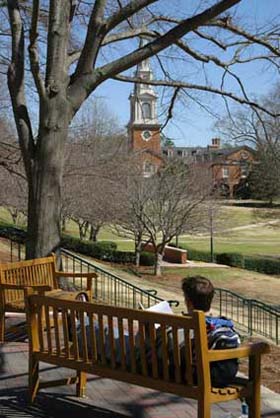 |
Improve Your Research Skills at Samford in Alabama
By Mary Dillon |
As genealogists, we are always researching, looking for those facts that define who our
ancestors were. And we're always looking for better ways to find the facts we need, new
ways and places to research.
So if you really want to learn how to research like an expert, I recommend the
Institute of Genealogy and Historical Research (IGHR) at Samford University in Birmingham,
Alabama. Held each year since 1963 during the second week of June, the IGHR offers a week
of intensive genealogical study led by nationally prominent educators. Many of the classes
offered by IGHR are accepted toward accreditation as a professional genealogist by the
Board of Certified Genealogists and by the NGS Home Study Course.
I attended the class in Southern Research this past June and had a great time. Not only
was the course intense and full of information, but both the students and faculty who
attend IGHR were friendly and share our interest in genealogy.
Although there are local hotels that offer IGHR rates, I chose to stay in the dorm
where $200 ($260 single occupancy) covers the dorm room for five nights and meals at the
cafeteria (very good). Orientation and check-in is Sunday afternoon and the course ends at
noon on Friday. While the dorms are typically well used and basic, they're adequate and I
found I didn't spend much time there. There is a shuttle that runs between the dorms and
the main campus on a regular basis for those of us who can't walk too far. If you take a
cab from the airport, you won't need a car for the week. Usually someone will share a ride
to Wal-Mart or other shopping if necessary. But be aware, if you live in the dorm you have
to provide your own bedding and towels. I have a daughter living in Montgomery, so I just
borrowed from her, but others just shipped a box if they were flying.
I found my days were too full of class, meals and evening lectures to have time to
think of anything else. I was usually in bed by 8:30 p.m., exhausted from the day, and up
by 6 a.m. to get breakfast before class. Even working full time, I'm not as disciplined as
I had to be at Samford.
At every meal I met new genealogy friends from all over the US (I believe there were
over 600 attendees in 2007) and it was fun to share stories with people who were actually
interested! I've kept in touch with some and look forward to seeing them next year.
Depending on the course you choose, there may be homework and/or prerequisites, so read
the descriptions well. The dorms have wireless service and most of us brought our laptops;
however, there are also computers in the library on main campus that are available until 9
p.m.
Instructors often had guest speakers from other classes who were experts in the areas
being taught that day. In the Southern Genealogy class, we had one professor of history
who was an expert in Kentucky and Tennessee, another whose expertise was Texas and another
who specialized in Cajun heritage and research. Many in the class were amateur
genealogists like me, some were research librarians expanding their knowledge and, of
course, some were working toward their professional genealogist certification. It was fun
to be in an academic climate with such a free flow of information.
Following is a list of classes being offered in June of 2008. Registration begins in
November. The website is http://www.samford.edu/schools/ighr
and registration can be done online. Last year's cost, if you registered before March 15,
was $375 for the course, plus housing costs.
Course Offerings -- June 8-13, 2008
1. Techniques and Technology
2. Intermediate Genealogy and Historical Studies
3. Research in the South, Part 1
4. Advanced Methodology and Evidence Analysis
5. Advanced Library Research: Law Libraries and Government Documents
6. Writing and Publishing for Genealogists
7. Virginia's Land and Military Conflicts and Their Effect on Migration
8. Land Records: Case Studies
9. Advanced Military Research III: Mexican War - Civil War
10. Irish Genealogical Research
11. Researching African-American Ancestors: Military Records
I highly recommend IGHR for anyone who wants to learn new research tools and experience
a great academic setting! I will be going back again next year to take the course in Irish
Research - Hope to see you there!
Return to Table of Contents
Don't Forget!
Dues are Due
by January 1, 2008
 |
G.R.O.W.
Genealogy Resources On the Web - The Page That Helps Genealogy Grow!
Compiled by Frank Geasa |
- The Cleveland Public Library (Ohio) has a death index (1913-1944) and an index of
transcribed cemetery records and newspaper notices for some years in the period from 1833
to 1975. It also has links to databases available for more current years.
- http://www.cpl.org/index.php?q=node/241
-
- Have you ever wondered why some census item was answered the way it was or why perhaps
there wasn't consistency in the way they were answered?
This site tells us the instructions given to the enu-merators for the 1850-1950 censuses.
Perhaps the inconsistencies can partially be due to the very length of some of these.
- http://usa.ipums.org/usa/voliii/tEnumInstr.shtml
-
- If your research includes Madeira Island (Portugal), the Regional Archives has online
indexes of marriages, baptisms and passports up to 1910/11. While the site is primarily in
Portuguese, there is an English version.
- http://www.arquivo-madeira.org/homepage.php?lang=1
-
- This Ogden City Cemetery (Utah) site, searchable by several different parameters, gives
not only the grave location but marks it on a map of the cemetery. Courtesy of Bill
Dumont.
- http://ims.ogdencity.com/cemetery/default.asp
-
- This Birmingham, Alabama Public Library site has several genealogy indexes available
online. While some require a library card, others including obituary, church, WPA and
cemetery indexes are available to everyone.
- http://www.bplonline.org/virtual/onlinedatabases/db_list.aspx?id=11
-
- This fascinating Historical Information System for Germany (HGIS) site allows you to
generate maps for different years and views of Germany (political, administrative, etc)
starting about 1815. You can also add overlays (roads, railroads, etc). It is in German
but has a limited English interface.
- http://www.hgis-germany.de
-
- This growing site has an online index of over 90,000 newspaper obituaries for Omaha,
Nebraska and surrounding areas. Covering the period 1901-1977, it lists name, date of
death and source. Information on obtaining copies is also provided.
- http://omahaobits.wordpress.com/
-
- This site has many links to Mennonite genealogy resources in Canada including church
registers, immigration lists and cemetery lists.
- http://www.mennonitegenealogy.com/canada/
-
- This site of Broward County, Florida, which in-cludes the Fort Lauderdale area, offers
online cemetery and marriage indexes.
- http://www.learnwebskills.com/browardcem/index.htm
-
- This Argentine genealogy site with over 125,000 names, offers searches by name and other
parameters. Spanish, English and French versions are available. Be sure to press the
[FIND] button after entering your data, hitting the Enter key will not suffice.
- http://www.familias-argentinas.com.ar/
-
- This Burlington County Library (New Jersey) site has indexes, some starting from the
early 1800s, for over 90,000 newspaper birth, mar-riage and death notices.
- http://sql.bcls.lib.nj.us/gen/
-
- This site of the city clerk's office of another Burlington (Vermont) has an online index
to the marriages in that city for the period 1800-1883.
- http://www.vt-fcgs.org/btvmarr.html
-
- This New Zealand National Library site has a digitized collection of old newspapers from
all over the country covering the years 1840-1915.
- http://paperspast.natlib.govt.nz/cgi-bin/paperspast
-
- This Chautauqua County, New York site in-cludes 24 town histories replete with
individuals' names.
- http://history.rays-place.com/ny/cty-chautauqua.htm
Return to Table of Contents
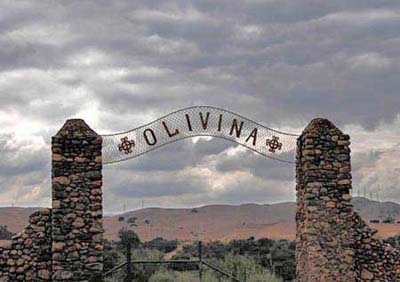 |
Civil War Veterans in Our Area
Were an Interesting Group
by Dick Finn |
Olivina Vineyards |
|
Who would have ever guessed that over ninety Civil War veterans lived here in the
Tri-Valley area at one time or another? All were Union vets except for two known
Confederates. Some lived here for many years, some for a year or two, and others for just
a short time. In a day and age when a very large percentage of men were farmers or farm
hands, our veterans held the same occupations in large numbers. But they also chose other
occupations. It turns out that many of our veterans were carpenters, which was surprising
to me. That was followed by merchants, saloonkeepers, building contractors, vineyard
owners and hotelkeepers. We also had a constable, chicken rancher, fisherman, druggist,
inventor, minister, and an undertaker.
A few turned out to be very famous. One of our veterans had a stepson who became the
most famous of all - an author whose books even today are among the most widely read
around the world.
Here are just a few of our veterans:
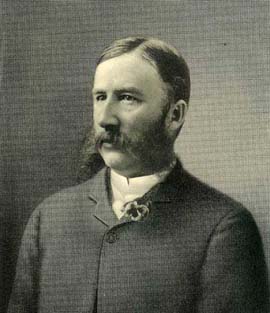
|
Julius Paul Smith |
Perhaps the most famous was Julius Paul Smith. Julius was the man who put borax into
small packages for home use, making home cleaning easier and making Julius and his brother
very wealthy. Julius used some of his wealth to develop the 2000 acre Olivina Vineyards
south of Livermore. During the Civil War, Julius was in the 22nd Wisconsin Infantry as
private.
Another person who lived in the valley for a time was William Thomas Simmons (related
to the Young and Sweet families). William helped build the old Young house on North Flynn
Road in the Altamont. But what makes William very famous is the fact that he received the
Congressional Medal of Honor for capturing the flag of the 34th Alabama Infantry, CSA.
During the Civil War, William was in Company C, 11th Missouri Infantry. He went in as a
private and was discharged as First Lieutenant. In later years, he was a Director of the
California Soldiers Home, Yountville, in Napa County. During his lifetime, William was a
carpenter, undertaker, merchant, and agent for the Wells Fargo Company.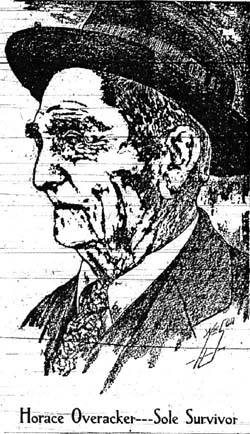
John London was the stepfather of author Jack London. John had a small farm off Alden
Lane. It was here that Jack London decided that he never wanted to be a farmer. But, in
later years, Jack's farm and ranch operation in the Valley of the Moon became famous for
the use of advanced techniques. John was not only a farmer, but also a carpenter,
storekeeper, and section boss on the railroad.
Another person of note is Eli M. Winning. He was the first full time minister at the
Methodist Church in Livermore. It turns out that a large number of the Civil War veterans
who lived in our valley were members of that church. Besides being a minister, Eli was the
town clerk of Los Gatos.
Daniel McCaw may be the most interesting of all of the veterans. Dan held a number of
jobs including saloonkeeper, hotelkeeper (including owning the Pleasanton Hotel), laborer,
constable, pound master. He must have been a hard worker - or perhaps could not keep a
job. Did you know that the big Dublin Gold Rush was said to be on land that Dan owned?
(Gold Creek is just south of Stoneridge Mall.)
The last known Civil War veteran to be living in the area was Horace T. Overacker, who
died on August 28, 1936. Horace lived in the hills south of Livermore, as did a number of
the area Civil War veterans. Horace was a farmer most of his life.
All in all, our Civil War veterans were a very interesting addition to our valley and
its history.
Return to Table of Contents
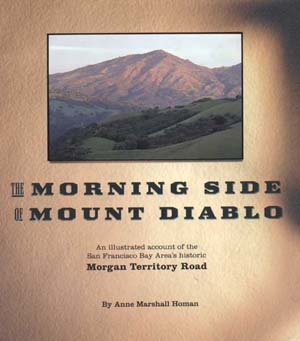 |
Writing Local History Books
By Anne M. Homan |
When I was almost finished with my first book, The Morning Side of Mount Diablo,
Seth Adams of Save Mount Diablo asked why I hadn't included a certain person in the book,
and I told him that I knew her daughter was planning a biography. He said, "I can't
tell you how many people have told me that they were going to write a book. You are the
only one who has done it." My husband buys old cars and restores them; after he has
finished with his restoration, we enjoy riding around in the car for a year or two before
he sells it. Often he buys a car from someone who had bought it many years before, but had
never gotten around to working on it. My main advice to any writer or car restorer is
simply to determine to follow through and finish. You need to realize at the beginning
that the project requires time. Each of my books, The Morning Side and Historic
Livermore, California: A-Z, took about five years of researching and writing.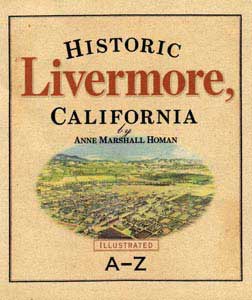
One of the most rewarding sources of information for my books was our local newspapers.
We are so fortunate here in Livermore to have a complete run from 1899 to today, well, to
at least last month, on microfilm. As many of you know, Barbara Bunshah made the
newspapers more accessible to researchers with her subject index. It is much more than a
subject index, however, because she lists not just a date and page under a subject
heading, but she lists a headline summary of each article and its date and page. So, for
example, if I wanted to write about the Sweeney Opera House, I could look it up in her
index and check out all the "headlines." The subject index is available up until
1950 on CD and up until 2002 in the white notebooks in the Livermore Library reference
section. Although she did not create a separate topic for most names, she did include a
list of obituaries for each notebook and on the CDs. These helped enormously when I was
trying to trace family histories. Barbara's subject index helped in another way, too. I
could page through it and check that Historic Livermore had covered the topics she listed.
Frequently, my researching involved me with Pleasanton history, but no one saved the
Pleasanton newspapers on microfilm, so there are only a few extant copies. In writing The
Morning Side of Mount Diablo, I used the microfilm of the Contra Costa Gazette
at the Contra Costa Library in Pleasant Hill. This little paper exists in an incomplete
run from 1860 to 1900, from 1905 to 1923 and from 1926 to 1963. It was helpful, but more
difficult to access information without Barbara's miraculous index.
For both of my books, my favorite research was interviewing people. I learned so much,
not only about families, but also about sewer systems and dry farming, about wetlands and
barber shops, about underground shelters and one-room school districts and so much more. I
made friends and delighted in learning new ideas. Often the people I interviewed had
photographs and ephemera they were willing to share as well as the names of others to
contact who were important to Livermore history. My two favorite interviews were with Dr.
Grace Devnich and Henrietta Greer. They are both going to celebrate their 100th birthdays
soon. Besides good health, I am sure that one of the reasons they have survived so long is
their great sense of humor. Henrietta recently entertained me for lunch at her ranch with
a fried chicken dinner, salad and homemade cake for dessert.
Sometimes, thanks to the Livermore Heritage Guild, I was able to hear interviews with
people that I have never met. The organization has interviews taped some years ago.
Listening to the voices of long-time residents who are dead now, for example, Johnie
Schneider, May Nissen, Warner "Dick" Holm and E.J. Mulqueeney was informative,
but a little eerie.
By researching in immigration records, church records, census records and cemetery
records, I was often able to help the families I became involved with learn more about
their history. Another source for land records and vital records was the county
clerk's office - for Alameda County, this meant trips to Oakland and for Contra
Costa County to Martinez. At Martinez, the original alphabetized deed books indexes are
available as well as microfilms of the deed books. Unfortunately, in Oakland both the
indexes and the deed books are on microfilm.
These were just some of my sources, and they should be familiar to researchers in
genealogy. You can find many others in the bibliographies and chapter notes in my books.
One of the promises I made to myself when I began writing local history was to be sure
that my sources were well documented. I also paid a professional to create the indexes for
both books. I have noted that some historians are not careful about these matters, and I
wanted to make my books as user-friendly as possible.
I felt fairly confident about my writing ability, but soon learned that a professional
editor adds a great deal - not only in finding errors, but also in making suggestions
about content, order of presentation and clarity.
How do you know when you're finished? You won't. You just have to decide to end the
project. Like genealogy, you could go on forever. And of course, you will find more
information and better photographs AFTER the book has been printed. I have been fortunate
to have my newspaper column where I can continue with new ideas and enlarge on earlier
ones.
Return to Table of Contents
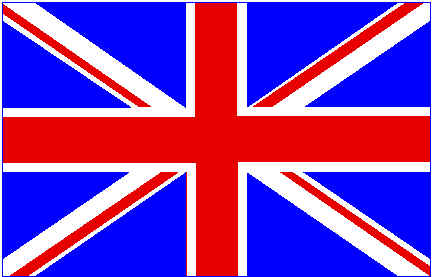
|
An Update About the UK Census
By Jeremy Frankel |
An article in the August issue of the Roots Tracer came to the attention of Jeremy
Frankel, who is the current President of the San Francisco Bay Area Jewish Genealogical
Society. That society regularly receives a complimentary copy of our Roots Tracer.
Mr. Frankel refers to Linda Garrett's article on page 19 about the future of the UK
Census and the government's not reducing the period to 70 years. The article ends with the
sad information that the 1931 census records were destroyed during the Second World War.
Mr. Frankel continues, "Actually, the situation is worse than was described. The next
census would have been taken in 1941. But because of the war, no census was carried out
that year. Hence, there is a gap of some 30 years between the 1921 and 1951 UK censuses.
And as we all know, a lot can happen in 30 years.
Return to Table of Contents
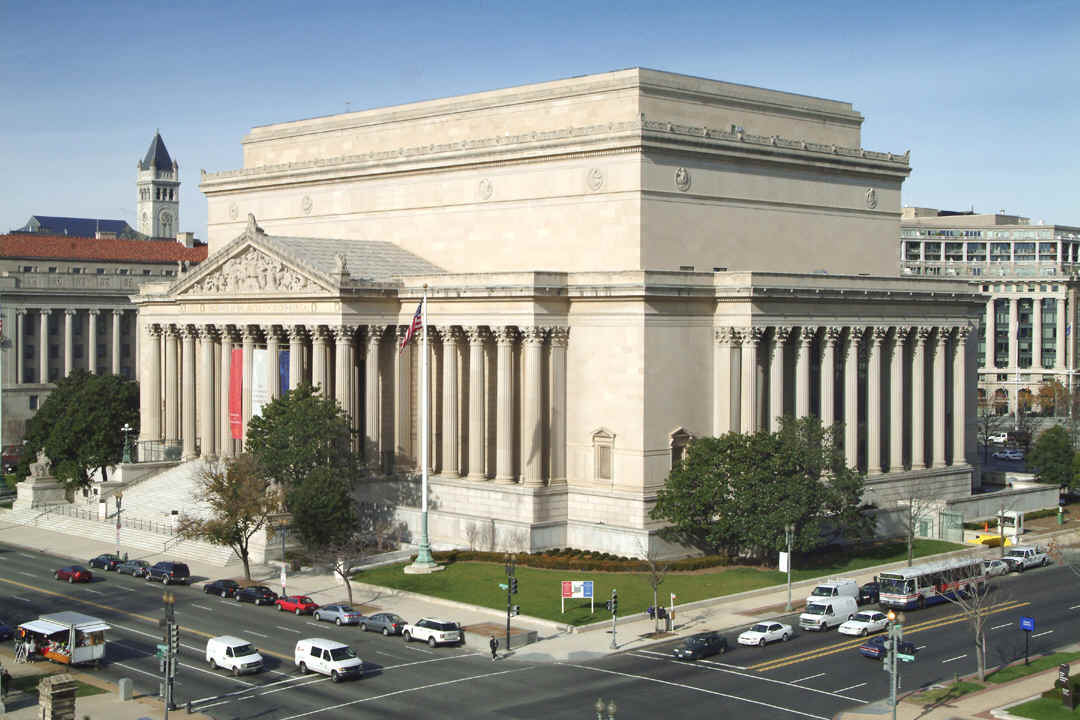
|
Members Helping Members
"Help! I'm at the National Archives Without My Research
Notes"
By Kay Speaks, Roots Tracer Reporter |
As the Chair for L-AGS' Study Group, I often receive e-mails from members requesting
assistance or suggestions for their genealogy research. Last March, Craig Fish wrote:
"I'm in Washington, DC for work. I will have Wednesday through Friday free to kick
around on vacation. I assume since I have not done my preparation, there is no value in
visiting the National Archives. Is there any valuable genealogic work I can do here
without preparation or without my notes?"
I thought this an excellent question and turned to my good friend and L-AGS member,
Susan Johnston, for help in answering Craig's question. Sue used to live in Maryland and
was a frequent visitor to the National Archives in DC.
Susan's response to Craig, with her subsequent annotations for the Roots Tracer version
in italics:
Dear Craig,
1. If you have somewhat unusual surnames and family here during the Civil War, I'd take
a look at the Civil War pension index to see if any rang a bell - either by name or by
location. If your major surnames are Smith and Jones, that might be a problem, though. :-)
Don't forget to look for siblings and in-laws, not just direct line people. This is
your chance to investigate collateral lines and those "I think this might be him, but
I'm not sure" people without paying the $75 price tag for each request.
2. The odds of Mexican War service/pensions depend on the location of your ancestors
during that time. If much of your family was already in the west, it might be worth a try.
The three major indexes are:
- Old War Index to Pension Files, 1815 - 1926 (T316)
- Index to Mexican War Service Pension Files, 1887 - 1926 (T317)
- Selected Pension Application Files relating to the Mormon Battalion (T1196)
3. Unless your family was very long-lived, War of 1812 pensions are not that likely,
and finding bounty land applications is problematic, unless you have a good idea of the
regiment a soldier served in. However, it might be worth a check. Bounty land was
issued for service in all wars up to, but not including, the Civil War. If you don't find
a soldier in the various pension files, add him to your bounty land search list. You need
the soldier's name and his regiment when requesting these "Unindexed Bounty Land
Applications" on site, so check the microfilmed service records first.
4. The passport application indexes cover the period through about 1925, if I remember
correctly. Since this brings you closer to the present, you might be able to think of
likely names. You might be surprised at the number of people who applied for passports.
Especially likely are businessmen, naturalized citizens, and those who had relatives in
foreign countries.
5. You will have access to a computer at the Archives, so it might also be worthwhile
to check the online land patent index, then order the original case files. Again, the
indexes are small enough that combining a less-than-common surname with a known location
may result in finding someone familiar. The case files may be very interesting. The index
is at: http://www.glorecords.blm.gov/ .
6. You may be able to remind yourself of people of interest via Ancestry.com,
especially the census index, at the Archives Library. Then, check out the 1880 delinquent
schedules, if available for your state, or the earlier agricultural schedules. None of
them are available on Ancestry at the moment.
7. The Civil War income tax schedules are on microfilm. You can get the list of states
with their corresponding microfilm numbers from this article: http://www.archives.gov/publications/prologue/1986/winter/civil-war-tax-records.html
. It's basically films M754 through M795. These lists are arranged by location, usually
state-county-town for each of the types of taxes, so if you know the general location, it
may be worth reading through these. San Bruno doesn't have many of them.
8. If you have Revolutionary War era people, and can remember the names, it's worth
looking at the pension files in film M804. What you find online are the selected records,
not the complete file. San Bruno does have this set, however, so this shouldn't be a
number one priority. Since writing this response, Footnote.com has begun putting M804
online as well.
9. Another set of records arranged by location are the Record of Appointment of
Postmasters. M1131 covers the years 1789-1832 and M841 covers 1832-1971. The latter,
especially, contains some surprising information. If you have family in a rural area,
these records might be helpful.
10. If you know of regular army relatives before WWI, now is the time to look for their
records. I don't have my notes handy on these records, so you'll need one of the people
there to get you started. There are a couple of routes to access these, and I'm not sure
which might work better if you don't have your notes.
11. There are usually genealogy volunteers there to help patrons. Of course, their
expertise varies, but you might be lucky. One of them may come up with some excellent
suggestions for you.
12. The Library at the Archives is always worth looking at. I think exploring the
shelves is fun. In other words, I'm so jealous! Good luck, and have a great time.
Regards, Sue Johnston
There are a few ways to keep your database and/or research task list handy.
- Some researchers keep their database on a Pocket PC and take it with them wherever
they go.
- You can keep your research to-do list in a spreadsheet file stored on a thumb drive.
That way, it's available whenever you have access to a computer, but note that you cannot
use a thumb drive in the Archives' computers.
- You can also upload your database via a GEDCOM file to RootsWeb or another online
site. That way, it's always available to you from any Internet computer, including those
at the National Archives.
Return to Table of Contents
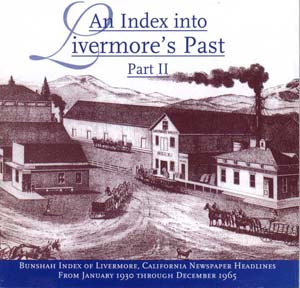
|
An Index into Livermore's Past
By Jane Southwick |
The cover of the second CD of Barbara Bunshah's
index, covering 1930-1965. |
|
The Livermore Public Library contains a very valuable resource. Anne Homan and Isabel
Nolte, who both wrote books involving Livermore history, refer to this resource in their
articles published in the Roots Tracer. Isabel's article was in the August 2007 issue, and
Anne's article is in this issue.
This resource, a series of 25 large notebooks, is an index of the early Livermore,
California, newspaper headlines. The books were created by the late Barbara Bunshah, who
was the reference librarian in the Livermore Library for many years. The newspapers she
indexed began in 1874, but the information in the books begins in 1899. Barbara agreed to
having this index compiled into two CDs, titled An Index into Livermore's Past, Part I and
Part II, which may be purchased for $5 each at the Livermore Public Library. The first CD
contains headlines from July 1899 through December 1929, and the dates of the second CD
are January 1930 through December 1965. The Library has the films of the newspaper
articles that are indexed in the books and CDs, and film readers are available to read
these articles.
Return to Table of Contents
"History is where the evidence leads us; heritage is what we choose to remember
and celebrate."
Edward T. Linenthal
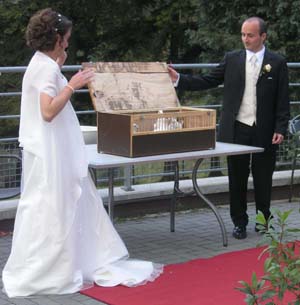
|
Romance and Relatives in the Vosges Mountains of France
By Patrick M. Lofft |
Our French connection — Andrea and Damien,
liberating doves at their wedding reception in Breitenbach, Alsace, France. |
|
My wife, Charlotte, has a third cousin once re-moved named Damien who was born in a
suburb of Strasbourg, France. Damien and his new bride now live in Frankfurt, Germany.
They came to Dublin in October 2005 for an 18-month stay while Damien worked in San
Francisco using a temporary visa. This allowed Charlotte and me to become well acquainted
with her French relative. Charlotte was able to help Andrea obtain a bookkeeping job with
Las Positas College. We really enjoyed their company and learned more about Charlotte's
"French Connection." Damien and Andrea returned to their apartment in Germany in
April of 2007.
Soon after they left, we received an invitation to their wedding. We were privileged to
attend a fabulous wedding celebration on Saturday, September 22, 2007 in the French Alsace
region of the Vosges Mountains at Mont Saint Odile.
Because European clergy, unlike their American counterparts, lack civil authority to
perform marriages, the civil ceremony had taken place a week prior to the Catholic
nuptials. On Saturday morning after the religious rites at Mont St. Odile, the matrimonial
motorcade traveled twelve miles through the forested Hohwald hills - horns blaring all the
way - to the reception at a secluded guest house, Villa Mathis, in Breitenbach.
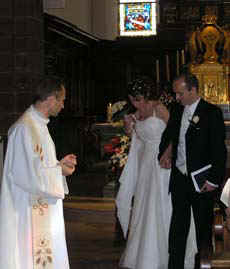
|
Recessional following the religious ceremony at
Mont Sainte-Odile, the holy mountain of Alsace. |
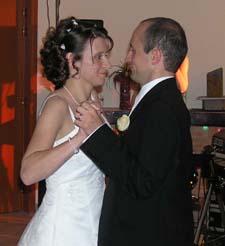
|
First dance for the bride and groom |
The reception continued all night and well into the early morning. The French really
know how to throw a wedding reception. An initial release of helium balloons was followed
by the liberation of doves. The preliminary festivities of the reception featured an
appetizer buffet with goose liver terrine, smoked salmon, smoked duck filet, Caesar salad,
gaspacho, etc., with a Riesling wine. The main course was medallions of deer from Hohwald,
chestnut flour spaetzle and sautéed mushrooms with a splendid red wine from Domaine de
Rimauresq in Provence. The subsequent cheese buffet was preceded by a fireworks display.
While the band was playing until well past midnight, the dancers enjoyed a luxurious
dessert buffet. Charlotte and I went to our room at one in the morning. The groom's
parents stayed with the revelries until three, while the groom called it quits at five
thirty. Even so, it seemed to me that we were among the last to arrive for the sumptuous
breakfast buffet. When we checked in at Villa Mathis our VISA card was declined as it is
the European custom that accommodations for invitees are the responsibility of the host.
So, I added further padding to the gift envelope.
In the days following the wedding, we reconnected with the other relatives whom we met
in 1998 when Charlotte sought out her formerly unknown kinfolk by knocking at farm gates
in Duttlenheim, Alsace, but that is a lengthier tale for another time.
Return to Table of Contents
You can find which states have counties of a certain name at this URL:
http://resources.rootsweb.com/cgi-bin/county.cgi
Previously published in RootsWeb Review: 1 August 2007, Vol. 10, No. 31.
Return to Table of Contents
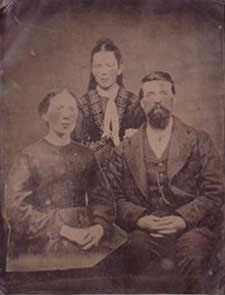
|
My Elusive Great-Grandmother, "L" Jones Carey
By Marie Wiley Ross |
This mysterious tintype contains the cutout image of
Great-grandmother “L,” unfortunately without her name. |
|
The reason I have to refer to my great-grandmother as "L" Jones is that I
have discovered different spellings of her first name in the few records I have found.
What do I really know about her from my four research trips to the Salt Lake City Library?
I do know that she was born to Elizur and Harriet Jones who were married in 1842 in
Rockford, Winnebago County, Illinois. "L" was born in 1844(?) but the birth
record has not yet been found.
I can find the family in Wisconsin in the 1855 and 1860 censuses. There is a Lafayette
listed as male, farmer, born in Illinois, who is the correct age (17) for "L"
and would be correctly the oldest of six children.
The 100-year history of Livingston County, Mis-souri, tells me that "L"s
father, Elizur Jones, and wife, Harriett (Barnes), "came there from Wisconsin in a
covered wagon in the 1860s with their six daughters, including Leafy, who married William
Carey." She is also mentioned as Leatha in another Livingston County history.
On my latest visit to the Family History Library in Salt Lake City, I found a marriage
record in the filmstrip of Dane County, Wisconsin, which states that Leefey M. Jones
married William Carey in January 1862. Family records say that their daughter, Minnie
Alice Carey, my grandmother, was born in the summer of 1862 in Wisconsin.
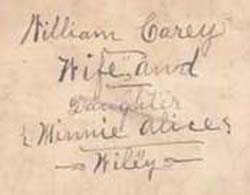 I find the three Careys together in the 1870 census in
Livingston County, Missouri: William, Leffey, and daughter, Minnie Alice. I have a tintype
of the Careys. There is a "cutout" picture of wife-and-mother "L"
somehow included in the tintype. Daughter Minnie looks about 10-12 years old. The paper on
the back says "William Carey, Wife, and Minnie Alice." Again, no spelling of
"L"'s name!
I find the three Careys together in the 1870 census in
Livingston County, Missouri: William, Leffey, and daughter, Minnie Alice. I have a tintype
of the Careys. There is a "cutout" picture of wife-and-mother "L"
somehow included in the tintype. Daughter Minnie looks about 10-12 years old. The paper on
the back says "William Carey, Wife, and Minnie Alice." Again, no spelling of
"L"'s name!
There is an Augustine Wiley on the same 1870 census page as the three Careys. In the
1880 Census, Minnie Alice is living with Augustine Wiley, and there is no trace of her
parents! Augustine will become her father-in-law when she marries Augustine's son, Joel.
Minnie Alice is an heir of her grandfather, Elizur Jones, on his death in 1896, along
with what seems to be a second wife and the five aunts who are the other daughters of
Elizur.
I am still working on this. I guess we all like mysteries! If you have any ideas for
me, let me know through L-AGS.
Return to Table of Contents
It is time to RENEW your MEMBERSHIP!

|
Finding My Grandmother - A Search with a Sad Ending
By Margaret Anne Newman Les |
The painting by my grandmother, Minerva Newman née
Baxter, that started my journey into genealogy. |
|
About 1963, while visiting relatives in Pennsylvania, Aunt Evelyn Newman gave me an oil
painting of roses-three colors of roses; actually, eight of them placed in a bowl on a
table. "Your Grandmother Minerva Newman painted this when she was a young girl."
I didn't quite know what to think of that, since no one had ever mentioned my Grandmother
Newman and this was such a gift she was giving me. As she put it, I was the oldest
granddaughter and should have it. It is framed in a gold tinted frame with the date of
1885 on the iron corner braces, and with the initials M.T.B. '94. Why don't we ask
questions that are obvious when we are children, or even when we've grown to adulthood?
Does it hurt to admit ignorance about a grandmother no one ever mentioned? I was
speechless, but kind enough to at least say I'll treasure it, and wonder how I'll get it
back to California while traveling with three kids in a Pontiac, pulling a pink, pop-up
camping trailer. We wrapped it carefully, and then went through some other old papers
found in a trunk in Canton, Pennsylvania, that later seem to have been connected to
Minerva's life.
The picture traveled safely across the country from Pennsylvania and was eventually
hung gently among many paintings done by other relatives on my husband's side of the
family, and among photographs taken for possible publication by my brother Tom. Although
my parents had done some genealogy of their families, I had never paid attention to them.
My brother Stu had seemed interested in looking for family in the 1970s, but he seemed to
only follow the surname Newman, man, to man, to man. (The women always get lost, don't
they?) He did have a cemetery picture of Minerva T. Newman's headstone in the town of
Canton, Pennsylvania, where my father had grown up.
When I finally had time to get into genealogy, and was encouraged to take what I knew
and go with friends to the Family History Library in Salt Lake City, it was fate - or
Minerva - that encouraged me to go and find her. This was now 35 years after I was given
the picture and both my parents and my husband had died. I did have some curiosity about
some of the data that Stu had found, and the story that perhaps our grand-parents were
married in New York where Grandfather Carroll G. Newman had worked at that time as a
telegraph operator.
My first thought was to find some marriage records in New York with my grandfather's
name or the Throgg's Neck Presbyterian Church on them, as that also was part of the family
lore. I found marriage records on three microfilm reels. I decided to gamble and look at
the middle one (or was it a gamble?) Within 10 minutes on that middle reel I found the
marriage license for Minerva T. Baxter and Carroll Newman. My friend sitting next to me
reading ships logs said I turned beet red and was speechless when I found it. I knew then
that Minerva was on my shoulder.
They had married in 1901 when they were both in their 30s in Westchester County, NY,
later to become The Bronx. This wonderful document had her full maiden name, her birthday,
her parents' names including her mother's maiden name.
With that information I was able to find her in the 1870 and 1880 census with siblings
and parents, but could never find her in the 1900 census, so that is still a mystery.
However, with the information I had, and a new computer, I put some queries out in the
area and within two months had some great leads.
The best lead was from a cousin who had recently moved to California. (We discovered
these facts about the fourth or fifth time we e-mailed information.) He had a copy of the
1976 Bronx County Historical Society Journal with an article "Westchester Township
and the Baxter Family".
What ever happened to Minerva is only partly answered by stories from a few letters
found in a family Bible, and some more research in the Pennsylvania records. After still
wondering why we never heard of Minerva in the 1930-50s, I found out she had died in an
institution in PA in 1923 where she had been since 1906. She was admitted within six
months of the birth of my father and, it is my suspicion from family stories, this was a
case of Post Partum Depression, which had no treatment in 1906.
Why is it that during this time I became involved in a post-partum depression group
that discussed the history and current state of treatment of this hidden disease? (This
group went on to work to increase awareness of PPD and gave workshops around California
and beyond.) Why is it that no one would ever talk about my talented, beautiful
Grandmother Minerva? If only these roses could talk.
The packaged picture that had traveled from Pennsylvania to California is now back in
Maryland. My sister has had it cleaned, and varnished for a total of $60. Now that seems
to make this priceless picture even more beautiful. I wonder what Minerva would think of
the history of art from when she was a young girl more than a hundred years ago.
About the Author
Anne Newman Les is not only a new member but also a new contributor to The Tracer. She is
a native Californian born in Riverside, one of five children. She is a graduate of
California State-Northridge, and a retired 8th-12th grade math teacher. Anne recently
moved to Livermore to reside with her daughter and family. Her family names of primary
interest are Newman, Les, Panek, Baxter, Emery, Walters, Covert, Freeman, Ullman, Swiatek
and Gibb, but she laughingly says there are many other names of interest. Her energy is
most welcome in the Tri-Valley!
Return to Table of Contents
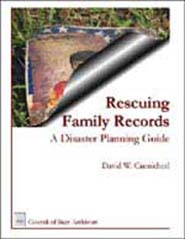 |
Council of State Archivists Press ReleaseRemember
Katrina!
Disaster-Proof Your Family Records
|
The Council of State Archivists (CoSA) is a national organization that works to ensure
that our nation's historical records are valued, preserved and widely used. A press
release from CoSA has announced the availability of a new book entitled Rescuing Family
Records: A Disaster Planning Guide, written by David Carmicheal, the Director of Georgia
Archives. After Hurricanes Katrina and Rita, Mr. Carmicheal led the nationwide effort by
the CoSA to better protect essential records.
This manual provides practical guidance to help individuals and families protect their
most important legal documents and irreplaceable pieces of family history from loss during
a disaster. It describes the records that protect a family's finances, health, civil
rights, and family history. The book prompts readers to think through all the
records that may help their family survive disaster and return to normal afterwards.
The 24 page manual is available for $10, plus $3 postage and handling, from
The Council of State Archivists
www.StateArchivists.org/prepare/families.htm
Return to Table of Contents

|
The Newbie Learns from the Expert that "This Is
Fun!"
By Jane Southwick |
Our Society received a request for help from Thelma, "I am trying to start my
family tree and it is quite hard. Believe my grandfather was born in 'York, New York', and
then have been told he was born in Australia coming from Italy. Every time I get on the
Internet they want Big $."
One of our members answered her:
"Hello Thelma,
"By way of introduction, I am Frank Geasa. I am the business manager for L-AGS and
a member of the organization's board. The one cardinal rule of genealogy is that you start
with what you know or can quickly find out - your parents. What are their names, including
your mother's maiden name, and when and where were they born. If they are still alive
and/or if older relatives are still alive, find out everything they know about the
generations before them - names, dates, places, etc. It is a process of continually
building upon what you know, playing detective, finding more pieces and fitting them in.
"You didn't mention your grandfather's name, but thought he might have been born
in 'York, New York.' I do not know of, or been able to find, a York, but do you think
perhaps it should be New York? If you can give me you grandfather's name and a ballpark
idea of his age at some point, I can do a little preliminary looking for you. I am
originally from New York and have done considerable research there looking for my own
ancestors.
"Your comment, about their wanting Big $ every time you get on the Internet, is a
common remark. If you live in Alameda County, the county libraries have Ancestry.com, the
premiere and expensive subscription site, available for use in the library. Additionally,
they have a second subscription service, Heritage Quest, which has the census records and
a few other items available from home using your library card number. The City of
Pleasanton Library and the City of Livermore, which are not part of the county system,
have both of these services available in the same fashion. Additionally, the City of
Pleasanton Library has the New England Historic Genealogy Society subscription site
available for use at the library. L-AGS maintains our genealogy library at the Pleasanton
Library and we have docents available there every Wednesday from 10 a.m. - 1 p.m. and from
6 p.m. - 9 p.m."
Frank and Thelma continued to correspond by e mail. They discovered that Thelma's
great grandfather was born in Italy and her grandfather was born in New York. The family
migrated to the San Jose area of California.
Frank was able to find records about her family on the Mormon Church's Web site, http://www.familysearch.org , which showed where
her great Grandfather had been born and died in Italy. Thelma had planned a trip to Italy,
so this information gave her a place to visit.
We also found data:
1. In the 1920 and 1930 census on Heritage Quest.
2. In the probate section of the San Francisco Genealogy Society, http://www.sfgenealogy.com.
3. At the California Genealogical Society site, www.calgensoc.org.
She found family wills there.
Thelma continues to find information about her family. It turns out that her family was
very active in the San Jose area, so there are a lot of records to find. Thelma's last
e-mail to Frank ended with "This is Fun."
Return to Table of Contents
Sutro Library to be open on Saturdays
|
Beginning November 3, 2007, the Sutro Library will be
open the first Saturday of each month, excluding holidays. |
 |
CSI - On-Scene Research Has Its Attractions
By George Anderson |
We recently decided to indulge again in what used to be one of our favorite pastimes -
shun-piking. In recent years, the price of gasoline and our decreased mobility in walking
made that activity less appealing, but we nevertheless headed off along the beautiful
Northern California and Oregon coast. We were blessed by gorgeous weather. Always alert to
a genealogical opportunity on these trips, we ended up across the Cascades in Bend,
Oregon. That was the site of a notable family event that deserved some first-hand
research.
In April 1924, my mother's second cousin, Dewey Morris, 22 years old, was one of the
victims in a triple murder. He and two partners were fur trappers in the mountain
wilderness west of Bend. Someone apparently ambushed them, cut a hole in the ice of a
nearby lake, and dumped in their bodies. The motive was theft of their valuable cache of
furs.
I first learned of the murder in 1989 when another researcher simply noted about Dewey,
"Cause of death: murder." I didn't attempt any further research about it until,
in an odd twist, a young nephew, Joe Noble, moved from Minnesota to Bend in 1993 to work
as a ski instructor. I asked Joe to look into it, knowing that he would be intrigued by
the task. He was and he spent many hours making photocopies of the newspaper stories. To
his chagrin, the copies made on the library's machine at the time completely bleached out
before he had a chance to mail them. By then, he was getting ready to move back to
Minnesota, so he wrote up a summary of what he had learned and sent it to me.
I did nothing further on the Dewey Morris case until September this year, when we
decided to end our week of sightseeing by going by way of Bend on our way home. We easily
found the event in the Bend Bulletin of 1924. It was front-page news for two
weeks, sometimes with two-inch banner headlines, apparently the biggest thing that had
ever happened in Bend. The editor even wrote a little front page story bragging that they
had published five editions of the paper in one day because of the murder story - a record
number for the Bulletin. We made copies of every story we could find. I will make
a small book out of them for family distribution.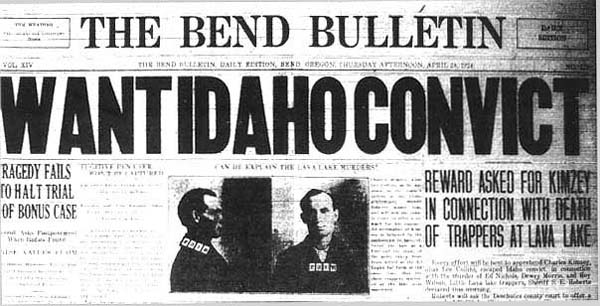
Who was the murderer? There was good evidence that he was Charles Kimzey, alias Lee
Collins, an escaped convict from Idaho. By the time the story had petered out in the
newspaper, he had not been captured. Since we returned home, I have searched every online
source I can think of and have not found mention of this crime and its legal outcome.
I did find that Charles Hyde Kimzey is mentioned several times in online genealogies.
Only one describes his misdeeds. That is the unsourced statement, "Spent 25 years in
the Oregon State Penitentiary for murder." The submitter of this statement withheld
any contact information.
I know I can write some letters and probably get documents about this crime, but I have
not done so yet. I also could have written to the library and bought the photocopies,
instead of traveling to Bend, but why spoil a chance for travel through the snow-capped
Cascades, past deep blue Crater Lake and around awe-inspiring Mount Shasta?
Return to Table of Contents
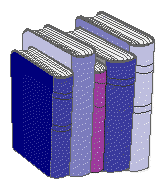 |
New at The Pleasanton Genealogy Library
Courtesy of Carl Cousineau
Library Services Manager |
A Time For Heroes : The Ancestors' Stories
Parks, Lemira Stubbs
Genealogy 929.373 PARKS
Return to Table of Contents
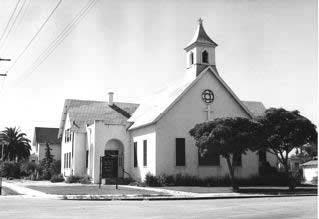
|
Asbury Methodist ChurchA New L-AGS Database, Coming
Soon
By Gail Bryan |
Asbury Methodist Church, 3rd and I Streets,
Livermore, CA - 1883 to 1961 |
|
Asbury Methodist Church celebrated its 140th anniversary on September 22 and 23, 2007.
Ten former pastors and associate pastors participated in the celebration, starting with
Rev. Newell Knudson (1947-1950).
Volunteers from L-AGS have recently finished transcribing records from Asbury
Methodist, and will publish their work in print and on the L AGS Web site. Jean Lerche,
Kathy Chase and I were the transcribers.
The church was organized in 1867 when Rev. T. H. Tooker and six members gathered in a
home in Livermore. The other six were Mr. and Mrs. John Manzer (Tooker's son-in-law), Mr.
B. F. Branon, Mr. and Mrs. A. A. Overacker and Mr. Scott. At that time, Livermore was a
small town of 400 people. Independent Hall (Exchange Hall) became the Methodists' meeting
place in 1868, when they rented a room over a saloon.
In 1870, Mr. William Martin Mendenhall, the founder of Livermore, donated a large lot
for a church building and parsonage. In 1873, under the leadership of Rev. Eli A. Winning,
plans were finally made to build a church building. Rev. F. F. Jewell dedicated the
church on January 13, 1884. The total cost had been about $3,100. This church building was
used until 1961 when the downtown location at Third and I Streets outgrew its space. The
buildings were sold for $40,000 and 10 acres of land was bought on East Ave. for $35,000.
The church continued to grow when Lawrence Livermore National Laboratory and Sandia
National Laboratory located in Livermore. The congregation first erected a social hall on
the new property followed by a chapel and educational wing. Other buildings have been
added to the campus over the years with a new sanctuary being dedicated in 1992.
Return to Table of Contents

|
In Memoriam
|
We lost two of our long time L-AGS members in September.
Dorothy Margaret Chappell died Monday, September 3rd, in Oroville,
California. Dorothy was an active participant in many of our study groups since 1998.
Because of her use of a walker, she was unable to attend our monthly meetings. She will be
missed. Her graveside services were held Wednesday, September 5, at Wyandotte Cemetery in
Oroville.
Dorothy Pace passed away Thursday, September 20th. She had been a
member since 2002 and attended an occasional monthly meeting until she was diagnosed with
terminal cancer. She will be dearly missed by all who knew her. Funeral services were held
Thursday, September 27th, at Callaghan's Chapel in Livermore. Interment was at San Joaquin
Valley National Cemetery in Gustine, California.
Return to Table of Contents
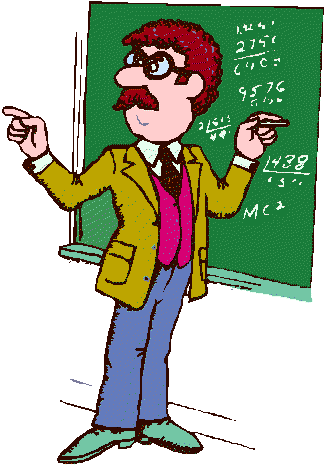
|
Upcoming Conferences
Compiled by Jane Southwick |
Registration brochures for the 2008 NGS Conference in the States and Family History
Fair will be available for download from the NGS website at http://www.ngsgenealogy.org beginning December
2007. If you would like to request a print copy of the registration brochure, please visit
http://www.ngsgenealogy.org/reqregbrochures.cfm
to request it.
L-AGS received the following invitation:
The San Francisco Bay Area Jewish Genealogical Society is pleased to invite any of your
members who are interested in joining us for a very special lecture by Marian Smith,
Historian of the US Citizenship and Immigration Service (USCIS , formerly the INS). We
have been trying for several years now to bring her out to the West coast, and have
finally succeeded! So this is a unique opportunity for us all.
Marian will be in the Bay Area for just one day, and will be our guest speaker at our
meeting on Sunday, January 13, 2008, at 1 p.m. We would love to be able to give her a
warm, and large audience! Our meeting will take place at the Jewish Community High School
of the Bay, 1835 Ellis Street, between Scott & Pierce, San Francisco.
Marian Smith's Presentation: Documenting Immi-grants to America, 1882-1954.
The lecture will focus on immigration and naturalization records of a typical late 19th
and early 20th century immigrant. Records in the custody of both USCIS and the National
Archives will be discussed, including ship passenger lists, Board of Special Inquiry
records, land border arrival records, visa files, legalization records, Alien
Registration, and naturalization and citizenship records. The presentation will conclude
with a lively Q&A session.
About the Speaker: Marian L. Smith is the Senior Historian at USCIS,
Department of Homeland Security. She regularly lectures at national and international
genealogy conferences on the history and uses of immigration and naturalization records.
Her articles appear in the National Archives journal Prologue, the FGS Forum,
and other publications. Her research focus primarily involves official immigration agency
records held in the National Archives in downtown Washington, D.C.
Return to Table of Contents
When Strangers Aren't
By Lois Smith |
A while back I received an e-mail from my cousin's son. He had been at a religious
celebration in Nevada when a nun walked up to him and pointed to his nametag. "I bet
you are my cousin," she said, "because your last name is Graveline." They
traded parents' names and decided they probably were indeed cousins.
Later, the cousin-one-removed asked me how they were related. Sure enough, a few days
later the nun e-mailed me, and asked me the same question. I explained to them both that
their grandparents were brother and sister, and therefore they were second cousins. I also
sent them descendant charts so that they could see exactly how they were related.
This is the fun part of being the "family genealogist."
Return to Table of Contents
Received by the LDS Family History Department:
"I am mailing you my aunt and uncle and 3 of their children."
From RootsWeb Review: Vol. 10, No. 6
Tri-Valley TMG and Study Group Schedule
By Kay Speaks |
Once again we approach the end of the year and our holiday season. The following is the
third quarter meeting schedule for TMG and the Study Group.
The Master Genealogist special interest group will not meet in November because I will
be on vacation. We will meet on Saturday, December 15, from 9 a.m.-Noon at 7077 Koll
Center Parkway in Pleasanton. Members and guests are welcome.
The Study Group will not meet in November or December because of conflicts with our two
federal holidays. Our next meeting will be on Thursday, January 24, 2008.
We look forward to many new topics of discussion at both computer interest groups in
2008. If you have a special lecture request or would like to be a presenter for the Study
Group, please contact me at study.chair@L-AGS.org. Have a wonderful and safe holiday
season.
Return to Table of Contents
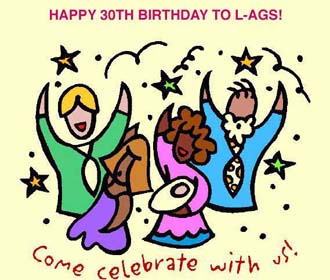
|
Our Thirtieth Anniversary - From 18 to 248 Members
By Lois Barber, L-AGS Historian |
The Livermore-Amador Genealogical Society (L AGS) began life as the Amador Genealogical
Association on June 27, 1977 with 18 charter members. Today the organization is 248
members strong. Although the name changed, the mission of the organization remained the
same, "to provide a central organization for residents of Livermore, Pleasanton,
Dublin, and surrounding areas who are interested in researching the history of their
families and tracing their families' ancestry."
Initially there were a variety of novel fundraisers to provide money to purchase books
for the organization's library and a high quality microfilm reader-printer for the
Livermore Li-brary. One of the novel ideas was to sell peacock feathers, donated by L AGS
member Dixie Newbury, who owned a farm outside of town. We are fortunate that today the
financial report shows a comfortable balance.
From the very beginning, library materials have been important to the Society. From a
library housed in a member's home to the current Pleasanton Library location, the library
collection continues to grow. A docent is at the library in the genealogy area on
Wednesday and Saturday, 10 a.m. to 1 p.m. and on Wednesday evening from 6 to 9 p.m.
In addition to the monthly general meeting with interesting speakers covering a variety
of genealogy topics, we are privileged to have three other special interest meetings.
There are two genealogy software meetings each month: The Family Tree Maker Group and The
Master Genealogist Users' Group. The Study Group meetings each month cover a wide variety
of topics; members are always welcome to pose a "brick wall problem" for help
from the group. The L AGS Board also meets monthly to keep the organization running
smoothly. Visitors to any of these meetings are always welcome.
Through the years, the organization has become known for its exceptional library,
excellent leadership, Web site, seminars, and civic endeavors, not to mention the
respected genealogical journal, The Roots Tracer, that you are reading. At the December
meeting we will celebrate the Thirtieth Anniversary of this wonderful organization. Where
else could one get so much for so little?
Return to Table of Contents

















 I find the three Careys together in the 1870 census in
Livingston County, Missouri: William, Leffey, and daughter, Minnie Alice. I have a tintype
of the Careys. There is a "cutout" picture of wife-and-mother "L"
somehow included in the tintype. Daughter Minnie looks about 10-12 years old. The paper on
the back says "William Carey, Wife, and Minnie Alice." Again, no spelling of
"L"'s name!
I find the three Careys together in the 1870 census in
Livingston County, Missouri: William, Leffey, and daughter, Minnie Alice. I have a tintype
of the Careys. There is a "cutout" picture of wife-and-mother "L"
somehow included in the tintype. Daughter Minnie looks about 10-12 years old. The paper on
the back says "William Carey, Wife, and Minnie Alice." Again, no spelling of
"L"'s name!








